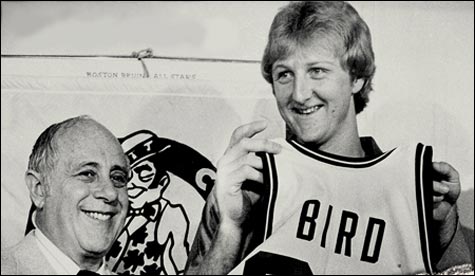The Celtics and the busing rift
By KEN BROCINER | February 13, 2009

HISTORY REVISED: Did Larry Bird really unite a racially divided city?
|
In the mid 1970s, violent opposition to the long-delayed desegregation of Boston's public schools made headlines all over the world. Now, some 35 years later, BostonHerald writer Michael Connelly has come out with a book that purports to tell the aftermath of this story from a new angle. According to Connelly, the deep racial wounds that were opened up by the Boston busing crisis of the mid '70s first began to heal when whites and blacks came together to support the Boston Celtics' championship team of 1981.
Why this team? The '81 Celtics comprised six white and six black players who valued teamwork. They captured the imagination of the city by staging a dramatic comeback against the Philadelphia 76ers in the Eastern Conference final and then going on to win their 14th NBA championship, and their first in five seasons. And they were led by one of the most popular athletes in Boston sports history: Larry Bird.
The book's 24 chapters mostly alternate between an entertaining history of the Celtics and an account of the conflict that reached a boiling point on June 21, 1974, when federal judge W. Arthur Garrity declared "that the entire school system of Boston" had been "knowingly" and "unconstitutionally segregated." Garrity ruled that the schools were to be integrated through the busing of large numbers of black students into white neighborhoods and a similar number of white students into neighborhoods that were mostly black.
What Connelly fails to establish is the connection between these events and the '81 Celtics and the racial healing that did eventually come to Boston. He points to the fact that the Celtics' victory rally in May 1981 (at which there were relatively few black fans) took place at the same Government Center location where, five years earlier, the image of a white man spearing a black man with the pole of an American flag had been immortalized in a Pulitzer Prize–winning Herald photo by Stanley Forman. But is that more than a coincidence?
Worse than any half-baked theory about racial healing in Boston is Connelly's historical revisionism. In his reinterpretation, the black and white communities were equally to blame for fanning the flames of the crisis, and busing itself was the primary cause of the violence that threatened to rip the city apart. He seems unaware of the implications of equating the black community's insistence on achieving its constitutional rights with the rights of those Bostonians who fiercely — and sometimes violently — opposed busing because they wanted to "preserve their way of life."
Connelly's own feelings about Judge Garrity's ruling come through in his description of the September 28, 1979, incident that left Darryl Williams, a black football player from Jamaica Plain High School, paralyzed from the neck down after he'd been shot during halftime of a game in all-white Charlestown. Three teenagers were arrested for the crime.
 Related
Related:
Amici, Wish list, Goal rush!, More 
- Amici
Remember the spirit and savor of the old-time North End red-sauce restaurants? Amici still does.
- Wish list
[1] An MBTA Red Line station without a broken escalator. [2] Someone in the White House who at least pretends we’re still looking for Osama.
- Goal rush!
Get two journalists in a room these days, and before the conversation is five minutes old they'll probably be kvetching about the grim state of the news business. Unless, that is, they happen to be sports journalists, in which case the conversation will likely focus on how absurdly bright the future looks. Especially here in Boston.
- NBA shoot-around
Sometimes, even superstar athletes just wear out their welcome. When Gilbert Arenas came into the league back in 2001, and especially after he moved to the Wizards in '03, "Agent Zero" was poised to be the next big thing in basketball.
- Life on the D-list
Last month Portland learned we'd be getting an expansion franchise in the NBA's D-League.
- Ten years of great sports
Moments after Adam Vinatieri's field goal split the uprights as the clock expired in the Louisiana Superdome on February 3, 2002, the streets of Boston were in bedlam. Drunk people dangled from trees and hung off lampposts. Motorists leaned on their horns. I saw a guy hug a cop
- Slam Dunk Season
Back in the fall of 2008, WJAB sports guy Chris Sedenka hosted Red Claws bigwigs Jon Jennings and Bill Ryan Jr. on his afternoon radio show. They were solidifying their plan to bring an NBA development league basketball team to Portland, Maine, a scheme that — in other circumstances, under others' supervision — had been previously unsuccessful.
- Busting Balls: 20 ways to improve sports
College football is stupid. Everybody knows it.
- Review: More Than a Game
Most know about the rise of LeBron James from impoverished Ohio roots (fatherless and raised in public housing) to mega-millionaire and NBA phenom, so why make a documentary?
- Injustice department
Thank you Harvey Silverglate for shining a light on our criminal-injustice system with your new book Three Felonies a Day. And thank you Peter Kadzis for a great interview.
- Hoop nightmare
It wasn’t quite the world-shattering, where-were-you-when moment as the space shuttle Challenger exploding into cottony plumes earlier that year. But I still remember my naive and dazed disbelief upon hearing that basketball star Len Bias had died of a cocaine overdose on June 19, 1986
- Less

 Topics
Topics:
Books
, Sports, integration, Education, More  , Sports, integration, Education, Special Interest Groups, African-American Issues, Racial Issues, Social Issues, Pulitzer Prize Committee, Boston Herald, Basketball, Less
, Sports, integration, Education, Special Interest Groups, African-American Issues, Racial Issues, Social Issues, Pulitzer Prize Committee, Boston Herald, Basketball, Less 